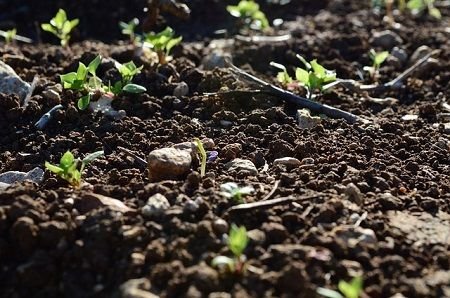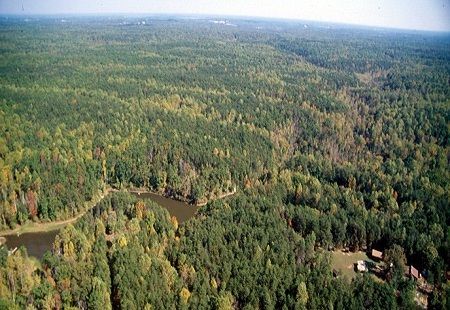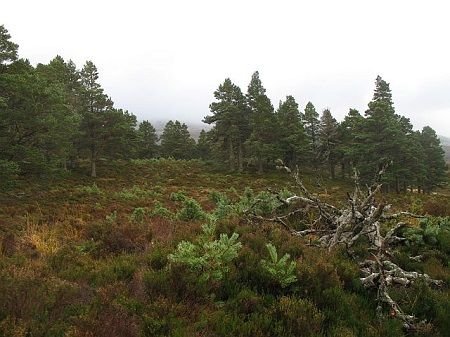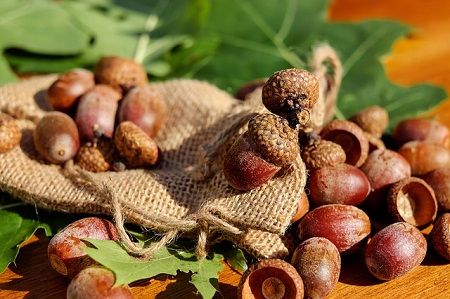Introduction to soil seed bank
When a forest is disturbed by processes such as anthropogenic or natural burning, degradation, deforestation etc. and then left for a particular period of time, such forest naturally heals itself provided enough time is given. Let us imagine a forest been burnt almost completely as in the image below;

If left sufficiently enough, this forest can flourish and more or less return to the status quo before the burning incident. Now, the question is;
How is it possible for such vegetation to naturally heal itself?
The answer is not far-fetched in what some of us might already know - the seed bank. For those that are not already familiar with the term, imagine an individual losing everything he/she has to natural disaster such as fire outbreak, flood, tsunami or any other anthropogenic or natural disaster; with every other thing being equal, such person will perhaps be left with whatever savings that he/she has in bank, right? Aside from assistance that can come from government, friends, family or any other source, the recovery of such person will be dependent on the resources in the bank. Such is the similitude of soil seed bank
The banks of vegetations: soil seed banks
Soil seed bank has been used to represent seeds or propagules (root fragments) that lie in the soil until the right conditions trigger their growth or as a reservoir of viable seeds present in a soil. This reservoir includes the seeds not germinated but have the potential to replace the annual adult plants, which had disappeared by natural death or not, and perennial plants that are susceptible to plant diseases and various disturbance regimes by animals, man inclusive. These viable seeds are present in the soil or sometimes mixed with soil debris. The origin of the life cycle of annual plants is the presence of their seeds in the soil, which is the main reason behind the persistence; in perennials, however, apart from the seed bank of the soil itself, there is an alternate bank of non-seed or vegetative propagules like tubers, rhizomes, and stolons which tend to augment the seed bank.
The seed density of soil seed bank is the number of seeds per unit area of soil and it varies depending on the nature of above-ground vegetation and the interactions within the vegetation community as a whole. The soil seed bank of an environment plays several key roles in the natural ecological processes of many ecosystems. The rapid re-vegetation of sites disturbed by wildfire, catastrophic weather, agricultural operations, and timber harvesting is largely due to the soil seed bank.
Forest ecosystems and wetlands contain a number of specialized plant species (especially tree species) forming persistent soil seed banks. The absence of a soil seed bank impedes the establishment of vegetation during primary succession, while presence of a well-stocked soil seed bank permits rapid development of species-rich ecosystems during secondary succession. Soil seed banks are also known to play a major role in determining the structure of plant communities, in the colonization of new areas and as a source of genetic variability. Generally, the potentials of forest ecosystems to regenerate from soil seed banks are higher in less disturbed ecosystems and can in particular act as a pool for regeneration after disturbances and can also act as a buffer against environmental stochastic spatiotemporal variability.
How important is the soil seed bank?
In the agroecosystems, the soil seed bank is closely related to weed studies. A good knowledge and understanding of seed bank composition/density are quite important when communities have been invaded by exotic or alien species and must be managed to either limit the invasion of the exotic species or promote desirable species. Several ecologists are of the opinion that the knowledge of the emergence rate of the different species from a soil seed bank can be used for the adequacy of soil and crop management programs, which can subsequently result in a rational use of herbicides. The weed seed banks have been studied more intensely than the others because of its economic importance.
Soil seed banks are important components of vegetation dynamics affecting both ecosystem resistance and resilience. Seed banks in arid ecosystems are characterized by high spatial and temporal variability and are particularly affected by spatial patterns of vegetation. Patches of soils under shrubs accumulate large seed banks as a result of the high seed output of clumped vegetation, the trapping of wind-dispersed seeds, the protection from predators, and possibly deposition by birds using the shrubs as perches. Researchers have reported that seed accumulation is highest in the center of the patch and decreases towards the edges. Under-storey habitats are areas of high plant diversity in dry ecosystems because of the high seed availability, along with its long persistence in the soil.
Classification of seeds in the soil seed bank
Seed bank composition can be classified as transient (temporary) or persistent according to the way they modify the regeneration of the vegetation during different time of the year. The mortality or viability of seeds in the soil is one of the key factors that determines the persistence and fluctuations in the density of populations of plants, especially when annual plants' populations are being considered. Transient seed banks are made up of seeds with short life, without being dormant and are dispersed in time for short periods during the year. On the contrary, persistent seed banks are composed of seeds that have more than one year of age and reserves of seeds remain in the soil year after year, generally buried into the soil.
The age of succession and the disturbance regime are the two main factors that determine whether a seed bank is transient or persistent. It has been reported that a significant carryover of seeds from one season to the next does not occur on sand dune systems and therefore they usually do not have a persistent soil seed bank because the shifting and dynamic nature of the substrate do not allow it. This assertion has been confirmed by the studies of the seed biology of several annual and biennial species. On the contrary, studies have shown that buried seeds of sand dune species can remain viable for more than two years thus providing the potential to form a persistent seed bank. In a study conducted in woody thickets in South African coastal dunes showed that frequently disturbed dune grasslands possessed a seed bank of comparative density compared to less-frequently disturbed.
Seed bank, seed germinations, and dormancy
Seed bank’s success depends on the percentage of seed that is ready to germinate when replacement of a plant is necessary and when the environmental conditions for establishment are favorable. The longevity of seeds is a prerequisite for survival of certain weed species, and this leads to a continuous source of emergency. The length of time a seed remains viable in the soil depends on species, features of the seeds, depth of burial, and general climatic conditions.
The ability of seeds to go dormant is another characteristic that affects the seed bank reservoir. The seed populations of several vegetable species behave in different ways with respect to germination; the weeds produce polymorphic seeds, with a certain proportion that is dormant and another group of seeds that is not. Several internal and external factors prevent seeds from germination, hence dormant. One of the internal factors is the presence of a seed coat which serves as a barrier to the penetration of water and oxygen; that is, seed coat impermeability. It has been reported in various literatures that seed coat impermeability to water, also called hard-seededness, causes dormancy in legumes and serves as a major factor in promoting the formation of soil seed banks.
In addition to impermeable seed coat, the presence of a biochemical inhibitor in the seed and or immature embryo also contribute to seeds being dormant. The most common among the external factors are soil water content and optimum temperature for germination. The term "innate dormancy" or "primary dormancy" has been and still being used to characterize the development of the dormancy in seeds while still on the mother plant, while "induced dormancy" or "secondary dormancy" is being used to describe the dormancy that developed after the dissemination or dispersion of the seeds in space. "Enforced dormancy" has been used for the inability of the seeds to germinate due to an environmental restrictions like water deficit, low temperature and poor aeration.
However, some seed physiologists do not consider the induced dormancy as an actual dormancy because the seed only refused to germinate due to the absence of favourable environmental conditions and requirements of the seed. Hence, the seed does not need breaking of dormancy but responds only to favorable conditions for germination. This situation is more conveniently refereed as a case of quiescent seeds according to several scientists. The process of dormancy represents a main mechanism of species preservation in the seed bank, enabling germination throughout the year. Moreover, it can guarantee the species survival in the form of seeds, under adverse conditions, even when the population of plants is completely eliminated. Different plant species have developed a range of seed dormancy strategies that allow dispersal prior to germination, and prevent germination when conditions are unfavourable for establishment.
Thank you for reading.
References
3. Benitez-Malvido, J., Martínez-Ramos, M., Ceccon, E. (2001). Seed rain vs seed bank, and the effect of vegetation cover on the recruitment of tree seedlings in tropical successional vegetation. Dissertatione Botanicae 346: 285-203.
7. Fernandez-Quintanilla, C., Saavedra, M. S., Garcia Torre, L. (1991). Ecologia De Las Malas Hierbas. In: Garcia Torre, L.; Fernandez- Quintanilla, C. Fundamentos sobre malas hierbas y herbicidas. Mundi-Prensa, Madrid, p.49-69
8. Freitas, R. R. (1990). Dinâmica do banco de sementes em uma comunidade de plantas daninhas com aspectos da germinação e dormência de sementes de capim marmelada (Brachiaria plantaginea (Link) Hitc.). Lavras, 118p. Dissertação (Mestrado) Escola Superior de Agricultura de Lavras.
Image Credits
*All images are from free sources





Very interesting!
I have a question though,
What do you mean by primary and secondary succession? The 'generation' (I'm sorry if that's not the right term) of plants that germinate after the soil meets the condition?
Also, in this seed bank is a reservoir of every vegetal species previously on the forest? What about seeds that are more sensible to suffer fire damage or those with a less effective 'dormant seed' mechanism? I assume they eventually reach the new forest, but by regular seed transport mechanisms?
I enjoyed reading a lot :)
let me first thaank you for coming and taking time out to read this article of mine. I will address the issues you raised one after the other;
Primary succesion means the establishment of vegetation on a soil that never had one while secondary succession is the gradual phasing out of the pioneer plant species and the ushering-in of new, more stable plant community.
Virtually, all seed-producing plants have representatives in the seed bank. However, these seeds might be more or less viable. If we include vegetative propagules like stem, remains of roots etc., all above ground vegetation should have seed bank progenies.
During fire, the fire-sensitive seeds are killed-off from the seed bank while the heat/smoke from the fire act as dormancy-breaking mechanism of certain dormant seeds. Not all forests can return to original status without manual planting of certain species.
Hope I have been able to answer your questions.
You're welcome. As I said, I enjoyed it.
My questions have been answered :) thanks!
Great read @gentleshaid, didn't know this whole soil seed bank thing, survival of the species is really important.
My country was just devastated by huge fires, and all the vegetation is already growing, it's just a shame that almost all of them are Eucalyptus, they burn so easily, what is your opinion on Eucalyptus as a botanist / plant ecologist / plant doctor
It depends on the species of the Eucalyptus although majority of them are naturally fire sensitive. I can bet it with time, most of the woody species in your country would become fire-tolerant if the trend of devastating fire continues annually.
Let's just hope that happens, only this year more than 100 ppl died because of forest fires.
Waiting for your next post @gentleshaid see you in SteemStem chat!
I once wrote an article on controlled burning as a way of preventing accidental forest fires. Forest managers in your country should have a look into this practice. See you!
I appreciate your style of writing and the way you explained the soil seed bank. That analogy of the way the forest self heals with the available seed bank and that of a man that lost everything to natural disaster and had to rely on bank savings made your explanation quite vivid. I must say you will make a good teacher too.
I am wondering if bush burning could degrade soil seed bank making it difficult for the forest to self heal? What of wind and water erosion? Do they have effect on the reserve of the seed bank?
Thanks @kaydee. I am actually a teacher.
Yes, bush burning could degrade soil seed bank, it can as well promote the emergence of some otherwise dormant seeds in the seed bank. A large percentage of herbaceous plant's seeds are very sensitive to fire, hence, they are the first to be cleared off during fire. However, fire can be a stimulant for dormancy breaking of some seeds of woody species, example is found in the Pinus's seeds.
Wind and water erosion sure do have effects on seed banks. Seedbank of vegetation in a windward side of slope has been found to be smaller than that of the leeward side of the slope. Run-offs in form of erosions also deplete seeds that are not deeply buried within the soil.
Keep up the good work @gentleshaid!
thanks :)
I've never heard much about soil seed bank, but you did a nice exposition on it.
Nicely written buddy
thanks Mr. sam :)
Hello, as a member of @steemdunk you have received a free courtesy boost! Steemdunk is an automated curation platform that is easy to use and built for the community. Join us at https://steemdunk.xyz
Upvote this comment to support the bot and increase your future rewards!
@gentleshaid for how long did you think one can store maize seed, without it been dispersed.
Well, I think it depends largely on where you are storing it. Perhaps you should clarify the question further.
I ask because most people use the local way which is by spreading the seed in the sun so as to make any form of water in the maize shrink out. But i don't know if these method of preservation can last more than six month or more.
If the grains are well dried, it will prevent fungal growth since those need water in order to reproduce. However, pests like weevils can still attack in the long run. So i will say drying method is ok in the short run but chemical preservatives against pest might be necessary if the plan is to store it in the long run
Hello @gentleshaid . You posted a link on the comment section of my post on sickle cell anaemia and love. I need authorization on the discord channel/group. Please reply.
here https://discord.gg/KrWykYs
Article really complete, I am impressed!
thank you!